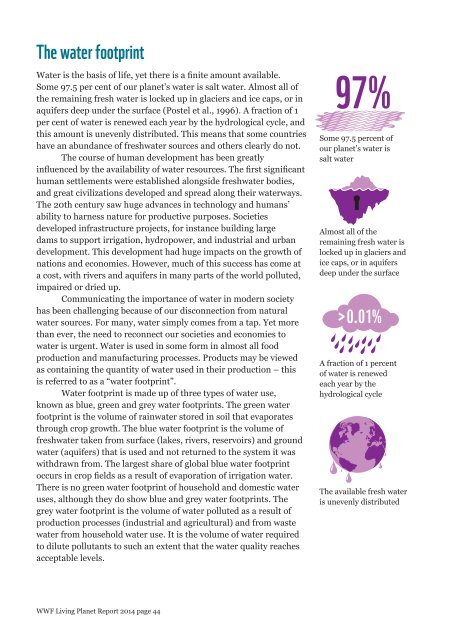5nvGuh
5nvGuh
5nvGuh
You also want an ePaper? Increase the reach of your titles
YUMPU automatically turns print PDFs into web optimized ePapers that Google loves.
The water footprintSome 97.5 per cent of our planet’s water is salt water. Almost all ofthe remaining fresh water is locked up in glaciers and ice caps, or inper cent of water is renewed each year by the hydrological cycle, andthis amount is unevenly distributed. This means that some countrieshave an abundance of freshwater sources and others clearly do not.The course of human development has been greatlyhuman settlements were established alongside freshwater bodies,and great civilizations developed and spread along their waterways.The 20th century saw huge advances in technology and humans’ability to harness nature for productive purposes. Societiesdeveloped infrastructure projects, for instance building largedams to support irrigation, hydropower, and industrial and urbandevelopment. This development had huge impacts on the growth ofnations and economies. However, much of this success has come atimpaired or dried up.Communicating the importance of water in modern societyhas been challenging because of our disconnection from naturalwater sources. For many, water simply comes from a tap. Yet morethan ever, the need to reconnect our societies and economies towater is urgent. Water is used in some form in almost all foodproduction and manufacturing processes. Products may be viewedis referred to as a “water footprint”.Water footprint is made up of three types of water use,known as blue, green and grey water footprints. The green waterfootprint is the volume of rainwater stored in soil that evaporatesthrough crop growth. The blue water footprint is the volume offreshwater taken from surface (lakes, rivers, reservoirs) and groundwithdrawn from. The largest share of global blue water footprintThere is no green water footprint of household and domestic wateruses, although they do show blue and grey water footprints. Thegrey water footprint is the volume of water polluted as a result ofproduction processes (industrial and agricultural) and from wasteacceptable levels.97%Some 97.5 percent ofour planet’s water issalt waterAlmost all of theremaining fresh water islocked up in glaciers andice caps, or in aquifersdeep under the surface>0.01%A fraction of 1 percentof water is renewedeach year by thehydrological cycleThe available fresh wateris unevenly distributedWWF Living Planet Report 2014 page 44


